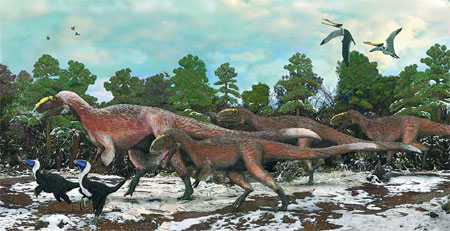Dinosaur species found
Updated: 2012-04-06 15:05
By Wang Ru (China Daily)
|
|||||||||||
 |
|
A picture of a newly discovered feathered dinosaur species, Yutyrannus huali, which means "beautiful, feathered tyrant" in a combination of Latin and Mandarin. Xinhua |
Scientists have discovered a new feathered dinosaur species that lived in the Early Cretaceous Period, about 125 million years ago, in northeastern China. The new findings, which are significant, provide direct evidence of the presence of extensively feathered dinosaurs and offer new insights into early feather evolution.
For more than a decade, scientists have known that some small dinosaurs had birdlike feathers, thanks mainly to beautifully preserved fossils from northeastern China.
Now three specimens of a new tyrannosauroid, whose members include Tyrannosaurus rex, show that at least one much larger dinosaur had a feathery coat.
The name of the new species, Yutyrannus huali, means "beautiful, feathered tyrant" in a combination of Latin and Mandarin. The three specimens were collected from a single quarry in Cretaceous beds in Liaoning province, northeastern China, and are described by Chinese and Canadian scientists in this week's issue of the journal Nature.
"The feathers of Yutyrannus were simple filaments," explained Professor Xu Xing of Beijing's Institute of Vertebrate Paleontology and Paleoanthropology, under the Chinese Academy of Sciences, the lead author of the study.
"They were more like the fuzzy down of a modern baby chick than the stiff plumes of an adult bird."
"From the sharp teeth and claws of the fossil, we know that the newly discovered dinosaur is a large predator like T. rex," Xu added.
The researchers estimate that an adult Yutyrannus would have been about 9 meters long and weighed about 1400 kg, making it considerably smaller than its infamous relative T. rex, but 40 times the weight of the largest previously known feathered dinosaur, Beipiaosaurus, a genus of theropod dinosaur recovered from the same region.
The large size of Yutyrannus and the downy structure of its feathers would have made flight impossible, but the feathers may have had another important function insulation.
The explanation may be climate-related, the researchers say. While the Cretaceous Period was generally very warm, Yutyrannus lived during the middle part of the Early Cretaceous Period, when temperatures are thought to have been somewhat cooler.
"Our research reveals that the average temperature of the period during which Yutyrannus lived was 10 centigrade lower than other periods of Cretaceous. The feathers could help the dinosaurs to keep warm," Xu told China Daily.
"It's similar to the woolly mammoth with their long hair, which survived in a glacial age. The traits are inherited and can be found on newborn elephants, which still have the filaments of hair," said Xu.
The gigantic T. rex and its closest relatives, by contrast, lived in the warm conditions of the Late Cretaceous Period. Isolated patches of preserved skin from these animals show scales, not feathers, but the possibility that even they were partly feathered cannot be ruled out completely.
"Yutyrannus dramatically increases the size range of dinosaurs for which we have definite evidence of feathers," Xu said. "It's possible that feathers were much more widespread, at least among the meat-eating dinosaurs, than most scientists would have guessed even a few years ago."
wangru@chinadaily.com.cn
Related Stories
Artwork displayed at Sotheby's 2011-10-08 09:35
Where dinosaurs once roamed 2011-10-13 11:04
A tick for flea studies 2012-03-28 10:28
Today's Top News
Rescuers race against time for quake victims
Telecom workers restore links
Coal mine blast kills 18 in Jilin
Intl scholarship puts China on the map
More bird flu patients discharged
Gold loses sheen, but still a safe bet
US 'turns blind eye to human rights'
Telecom workers restore links
Hot Topics
Lunar probe , China growth forecasts, Emission rules get tougher, China seen through 'colored lens', International board,
Editor's Picks

|

|

|

|

|

|





